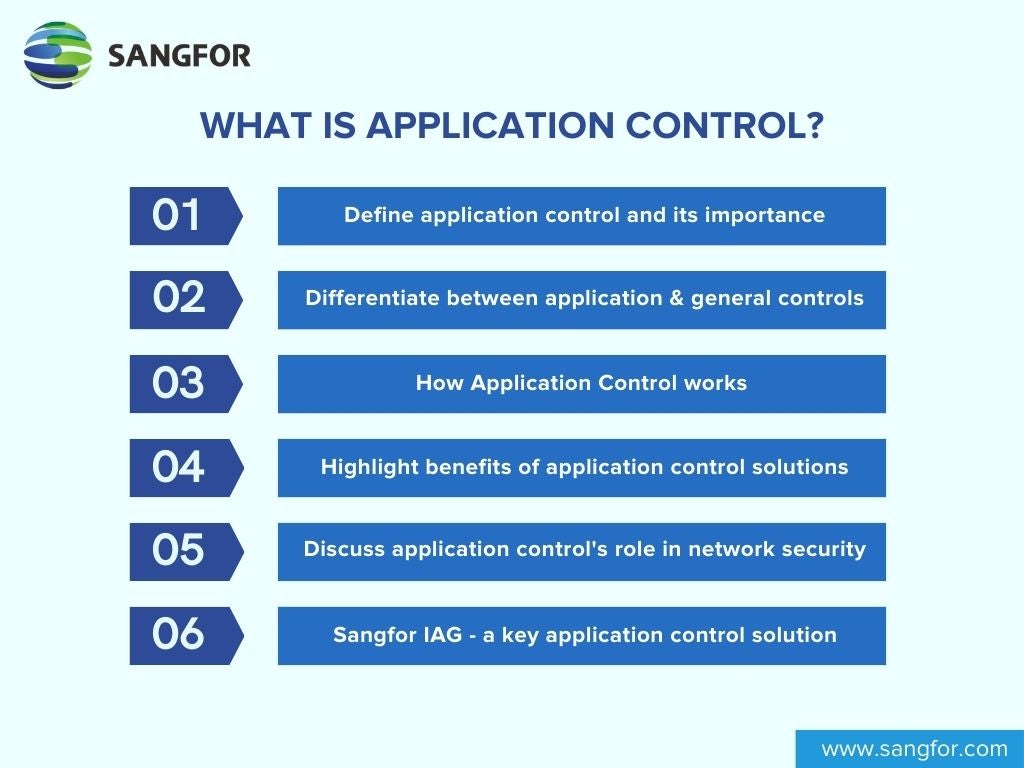In today's rapidly evolving digital landscape, businesses face an ever-growing array of cyber threats. Cybersecurity is important due to threats like malware, ransomware, data breaches, and insider threats. Strong measures are necessary. At the forefront of defence strategies lies the concept of application control.

What is Application Control?
Application control refers to regulating and managing application usage within an organization's network environment. It involves the identification, monitoring, and control of both authorized and unauthorized applications to enhance security and mitigate risks.
Application controls are a segment of network security which allows only approved or “safe-listed” files to bypass endpoints while blocking “black-listed” or potentially malicious files wishing to enter your network through applications. Application control is most useful for organizations with BYOD (Bring Your Own Device) policies and prevents damage caused by unknown applications which could contain potentially dangerous files. Application Control is designed to make management and safeguarding of a network easier and quicker, giving administrators automated and granular control over each application, and thus over endpoints, blocking both external and internal threats to the network and users.
Application Controls vs. General Controls
Application controls specifically focus on the security and functionality of applications within a network. They regulate how applications interact with data and users, ensuring that only authorized applications are executed. Examples include whitelisting applications, monitoring application behavior, and blocking unauthorized access.
In contrast, general controls apply more broadly to the entire IT environment. They include policies and procedures for overall security management, such as access controls, physical security measures, and disaster recovery planning. While application controls are crucial for safeguarding specific applications, general controls provide a framework for protecting the entire information system.
What Type of Security Control is Application Control?
Application control is considered a preventive security control. Its primary function is to prevent unauthorized applications from executing, thereby reducing the risk of security breaches and data exfiltration. By enforcing strict policies regarding which applications can run within an organization’s network, application control helps maintain a secure environment and protects sensitive data. Moreover, application control can also function as a detective control by monitoring application behavior and identifying any suspicious activity. This dual capability enhances an organization's overall security posture by not only preventing threats but also providing visibility into potential vulnerabilities.
What is the History of Application Control?
As early as the 1970s, many organizations were paying attention to application development – albeit in its early days. As application development became more commonplace, enterprises started to recognize the higher level of productivity and ease of maintenance that came with application development, and the vitality of application control to the success and safety of an enterprise network.
As applications became more numerous and easy to create and deploy, methods of control became more vital. Application control has evolved as a response to the growing complexity and security risks associated with the use of applications within organizations.
While its beginnings were rudimentary, application control developed in line with the application development industry – in leaps and bounds, leading to its position today as a vital part of every enterprise IT security set-up.
How Application Control Works
Application control operates by scrutinizing and managing application usage and comparing it against predefined models or standards. These models may include lists of approved applications, known malware signatures, or behavioural patterns indicative of malicious activity.
When a user or system attempts to execute an application, the application control mechanism evaluates its legitimacy based on these predefined criteria. If the application matches an approved entry on the whitelist, it is allowed to run. Conversely, if the application matches a known malware signature or is flagged as unauthorized, it is blocked from execution.
By understanding these standards, application control mechanisms can differentiate between legitimate and malicious traffic, thereby enabling organizations to enforce policies that govern application usage effectively.

Key Features and Benefits of Application Control
Both individuals and organizations have become reliant on applications for everything from leisure to business operations. Monitoring and controlling data security threats is essential to continued business growth and productivity. Application Control solutions provide several critical functions to IT and network security administrators including:
Identifying and Controlling Applications
Application control provides organizations with visibility into the applications present in their IT environment. By maintaining a comprehensive inventory of authorized applications, organizations can make informed decisions about their usage, licensing, and security implications.
For example, a financial institution may choose to restrict the use of peer-to-peer file-sharing applications within its network to mitigate the risk of data leakage and compliance violations. Similarly, organizations may monitor parental control applications to ensure that they are used effectively to protect children online.
Preventing Unauthorized Applications
One of the primary benefits of application control is its ability to prevent the execution of unauthorized or malicious applications. Organizations can lower security risks by only allowing approved applications and blocking all others by default with a whitelist.
A healthcare organization may have strict rules for installing and using software on its medical devices. These rules are in place to keep patients safe and ensure compliance with regulations. Additionally, birth control applications may be monitored to ensure they are used responsibly and do not compromise user privacy.
Reducing IT Complexity
By eliminating unknown and unwanted applications, organizations can streamline their IT infrastructure and reduce operational complexities. This simplification enhances efficiency and improves the overall security posture by minimizing the attack surface and potential points of compromise.
For instance, a manufacturing company may implement application control to standardize software deployments across its production facilities, reducing compatibility issues and support overhead.
Enhancing Network Stability
Application control enhances overall network stability and performance by identifying all applications running within the endpoint environment. By monitoring application behaviour and resource utilization, organizations can proactively identify and address performance bottlenecks and security vulnerabilities.
A retail store can use application control to enhance its point-of-sale systems. This ensures that customers can always use them smoothly. This is important during peak shopping times. It helps to prevent any issues or delays for customers.
For example, a retail chain may use application control to monitor the performance of its point-of-sale systems. During peak shopping seasons, this can ensure uninterrupted service for customers.
Protecting Against Exploits
Application control safeguards against exploits of unpatched operating systems and third-party application vulnerabilities by preventing the execution of unauthorized or untrusted code. By enforcing strict access controls and application whitelisting policies, organizations can minimize the risk of exploitation and data exfiltration.
For instance, a government agency may implement application control to prevent unauthorized access to sensitive information and critical infrastructure, thereby safeguarding national security interests.
How does Application Control help with network security?
Network security requires IT administrators to have full visibility into applications, files and users, and complete control over storage, access or endpoints, and all data, at rest or in transit. This type of control helps with data discovery, classification of both risky and safe applications, and compliance, allowing IT administrators total control of their network traffic, threats, data patterns, key features and behavioural characteristics of applications, and who is using them.
Sangfor IAG
Application control is a security technology built into Sangfor's IAG solution, providing a secure web gateway between users, applications and the network, and the ability to identify any applications' particular traffic flow. Other network performance and security benefits include:
- Minimizing access to non-business related sites and distractions
- Providing an intelligent billing solution
- Maximizing bandwidth usage and availability
- Minimizing leakage and regulatory risks and protecting intranet data security
- Providing visual management and comprehensive control of wireless APs
- Enabling unified internet behaviour management for wired and wireless networks
- Simplifying legal compliance with simplified cross-regional controls
To further deepen your understanding of Sangfor IAG, you might find this video helpful:
As a leading vendor of Network Management solutions, Sangfor's IAG Secure Web Gateway has been listed in the SWG Gartner Magic Quadrant for 10 consecutive years. Sangfor IAG is a superior Internet behaviour management solution consisting of professional Internet bandwidth management, application control, URL filters, traffic control, information control, illegal hotspot/proxy control, behaviour analysis, wireless network management and many more features. This solution can truly help you achieve effective web filtering and unified internet behaviour management of all clients in the entire network.
Application Control Frequently Asked Questions
In today's digital landscape, application control serves as a critical component of cybersecurity strategies, aiming to regulate and manage the usage of applications within organizational networks. By enforcing policies and mechanisms to govern application execution, organizations can enhance security, mitigate risks associated with unauthorized or malicious software, ensure regulatory compliance, and preserve operational productivity. Application control not only safeguards critical assets and data but also supports broader business objectives by fostering a secure computing environment conducive to innovation and growth in an ever-evolving threat landscape.
Application control significantly enhances network stability by meticulously identifying and regulating the applications operating within an organization's endpoint environment. Through the implementation of robust policies and mechanisms, application control minimizes the likelihood of system disruptions stemming from unauthorized or unapproved software. By gaining granular visibility into application usage patterns, organizations can effectively allocate resources, prioritize critical applications, and optimize network performance. Real-time monitoring of application behavior enables proactive identification and mitigation of potential threats, safeguarding against security breaches and preserving network stability. In essence, application control serves as a cornerstone of a resilient and well-managed network infrastructure, enabling organizations to adapt to evolving business needs while mitigating the risks posed by malicious activities.
Application control serves as a pivotal defense mechanism against malware by actively thwarting the execution of unauthorized or malicious applications within an organization's network infrastructure. By meticulously maintaining a whitelist of approved applications and blocking all others, application control creates a robust barrier against malware infiltration, including emerging and zero-day threats. This proactive approach not only minimizes the attack surface but also provides real-time visibility into application behavior, enabling organizations to swiftly detect and respond to potential security breaches. Through containment and mitigation strategies, application control helps limit the impact of malware incidents, safeguard sensitive data, and ensure uninterrupted business operations, thus reinforcing the organization's overall cybersecurity posture in an ever-evolving threat landscape.
Application control significantly influences user productivity and experience by establishing a secure and streamlined computing environment. While the setup and configuration of application control systems may demand initial effort, the long-term advantages are substantial. By enabling organizations to define and enforce policies regarding application usage, users can concentrate on their core responsibilities while minimizing distractions and potential security risks. Clear and consistent access policies empower users to navigate their computing environment confidently, knowing they are operating within organizational guidelines. Moreover, by blocking unauthorized or harmful applications, application control reduces disruptions, ensuring a stable and secure user experience. This fosters a culture of accountability and compliance, helping organizations adhere to regulatory standards while enhancing overall security posture and user satisfaction. In essence, application control cultivates a productive and secure computing environment where users can operate efficiently and confidently, contributing to organizational success.





